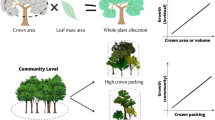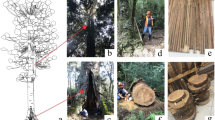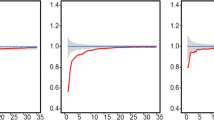Abstract
Accurate estimation of tree stem form and merchantable volume is an important prerequisite for forest management and economic evaluation. A system of compatible taper-volume equations was constructed for estimating the upper stem diameter and merchantable volume of different larch species in northeast China using Larix olgensis (LO) and Larix kaempferi (LK) as examples. Five common compatible taper-volume systems were evaluated by using the diameter, height, and cumulative volume data of 262 LO and 86 LK trees. The seemingly unrelated regression (SUR) was used for parameter estimation of the nonlinear simultaneous equations, and the power function was applied to eliminate the heteroscedasticity of the volume equations. Subsequently, the tree species were used as dummy variables to construct generalized equations suitable for the two species. Finally, the adjusted coefficient of determination (\({R}_{a}^{2}\)), root mean square error (RMSE), Akaike information criterion (AIC), RMSE%, condition number (CN), mean absolute bias (MAB) and mean percentage of bias (MPB) were used to evaluate the performance of the model. The segmented model outperformed the simple model, and in particular, the model presented by Fang (FS 46:1–12, 2000) exhibited the best performance in predicting diameter and volume. The Fang (FS 46:1–12, 2000) model explained the difference in stem form between both larch species, that is, LO had a higher upper inflection point and a lower inflection point than LK. The dummy variable model provides an effective approach to accurately predict stem diameter and volume variables for both species. The generalized equation can be used for simultaneous estimation of stem taper and merchantable volume for LO and LK in northeast China. Under the same conditions, LO has longer middle segments and better stem form than LK.




Similar content being viewed by others
References
Alkan O, Özçelik R (2020) Stem taper equations for diameter and volume predictions of Abies cilicica Carr. in the Taurus Mountains. Turkey J Mt Sci 17:3054–3069
Belsley DA (1991) Conditioning diagnostics, collinearity and weak data in regression. Wiley Stats Ref Statistics Reference, New York
Bohora SB, Cao QV (2014) Prediction of tree diameter growth using quantile regression and mixed-effects models. For Ecol Manag 319:62–66
Cao QV, Burkhart HE (1980) Cubic-foot volume of loblolly pine to any height limit. South J Appl for 4:166–168
Castedo-Dorado F, Diéguez-Aranda U, Barrio-Anta M et al (2007) Modelling stand basal area growth for radiata pine plantations in Northwestern Spain using the GADA. Ann for Sci 64:609–619
Corral-Rivas JJ, Diéguez-Aranda U, Rivas SC et al (2007) A merchantable volume system for major pine species in El Salto, Durango (Mexico). For Ecol Manag 238:118–129
Demaerschalk JP (1972) Converting volume equations to compatible taper equations. For Sci 18:241–245
Diéguez-Aranda U, Castedo-Dorado F, Álvarez-González JG et al (2006) Compatible taper function for Scots pine plantations in northwestern Spain. Can J for Res 36:1190–1205
Dong LB, Lin XY, Zhang YF et al (2022) Optimal rotation of Larix olgensis plantation in considering carbon sequestration and timber production. Sci Silvae Sin 58:18–30
Fang Z, Borders BE, Bailey RL (2000) Compatible volume-taper models for loblolly and slash pine based on a system with segmented-stem form factors. For Sci 46:1–12
Fu LY, Tang SZ, Zhang HR et al (2015) Generalized above-ground biomass equations for two main species in northeast China. Acta Ecol Sin 35:150–157
Goulding CJ, Murray JC (1976) Polynomial taper equations that are compatible with tree volume equations. N Z J for Sci 5:313–322
He P, **n SD, Jiang LC (2020) Research on stem taper equation of Scots pine based on generalized additive model. J Bei**g for Univ 42:1–8
He P, Hussain A, Shahzad MK et al (2021) Evaluation of four regression techniques for stem taper modeling of Dahurian larch (Larix gmelinii) in Northeastern China. For Ecol Manag 494:119336
Hussain A, Shahzad MK, He P et al (2020) Stem taper equations for three major conifer species of Northeast China. Scand J for Res 35:562–576
Jia WW, Chen DS (2019) Nonlinear mixed-effects height to crown base and crown length dynamic models using the branch mortality technique for a Korean larch (Larix olgensis) plantations in northeast China. J For Res 30:2095
Jia WW, Sun HM, Li FR (2019) Prediction model system with dummy variables for carbon storage of larch plantation in Heilongjiang Province. China Chin J Appl Ecol 30:814–822
Jiang LC, Liu RL (2011) Segmented taper equations with crown ratio and stand density for Dahurian Larch (Larix gmelinii) in Northeastern China. J for Res 22:347–352
Jiang LC, Brooks JR, Wang JX (2005) Compatible taper and volume equations for yellow-poplar in West Virginia. For Ecol Manag 213:399–409
Jiang LC, Li FR, Liu RL (2011) Compatible stem taper and volume models for Dahurian larch. J Bei**g for Univ 33:1–7
Jiang LC, Ma YY, Li YX (2016) Variable-exponent taper models for Dahurian Larch in different regions of Daxing’ anling. Sci Silvae Sin 52:17–25
Lee WK, Biging GS, Son Y et al (2006) Geostatistical analysis of regional differences in stem taper form of Pinus densiflora in central Korea. Ecol Res 21:513–525
Li FR (2019) Forest mensuration, 4th edn. China Forestry Press, Bei**g, China
Li RX, Weiskittel AR (2010) Comparison of model forms for estimating stem taper and volume in the primary conifer species of the North American Acadian Region. Ann for Sci 67:302
López-Martínez JO, Vargas-Larreta B, Aguirre-Calderón OA et al (2020) Compatible taper-volume systems for major tropical species in Mexico. For Int J for Res 93:56–74
Max TA, Burkhart HE (1976) Segmented polynomial regression applied to taper equations. For Sci 22:283–289
Meng XY (1982) Studies of taper equations and the table of merchantable volumes. J Nan**g Technol Coll For Prod 25:122–133
Özçelik R, Crecente-Campo F (2016) Stem taper equations for estimating merchantable volume of Lebanon cedar trees in the Taurus Mountains, Southern Turkey. For Sci 62:78–91
Özçelik R, Karatepe Y, Gürlevik N et al (2016) Development of ecoregion-based merchantable volume systems for Pinus brutia Ten. and Pinus nigra Arnold. in southern Turkey. J for Res 27:101–117
Özçelik R, Cao QV, Trincado G et al (2018) Predicting tree height from tree diameter and dominant height using mixed-effects and quantile regression models for two species in Turkey. For Ecol Manag 419:240–248
Parresol BR (1993) Modeling multiplicative error variance: an example predicting tree diameter from stump dimensions in baldcypress. For Sci 39:670–679
Qiao JJ, Sun YJ (2022) Effects of altitude and slope on the climate–radial growth relationships of Larix olgensis. A Henry in the southern Lesser Khingan Mountains. Northeast China. Ecol Process 11:46
Quiñonez-Barraza G, De Los Santos-Posadas HMM, Álvarez-González JG et al (2014) Compatible taper and merchantable volume system for major pine species in Durango, Mexico. Agrociencia 48:553–567
Quiñonez-Barraza G, Zhao DH, De Los Santos-Posadas HM (2019) Compatible taper and stem volume equations for five pine species in mixed-species forests in Mexico. For Sci 65:602–613
Shahzad MK, Hussain A, Jiang LC (2020) A model form for stem taper and volume estimates of Asian white birch (Betula platyphylla): a major commercial tree species of Northeast China. Can J for Res 50:274–286
Subati S, Jia WW (2021) Construction of the additive model system for heartwood, sapwood and bark taper of Pinus koraiensis plantation in different regions of Heilongjiang Province. China Chin J Appl Ecol 32:3437–3447
Wang M, Li FR (2018) Modelling individual tree diameter growth for Larix olgensis based on thinning effects. J Nan**g for Univ Nat Sci Ed 42:28–36
Wang ML, Kane MB, Borders BE et al (2014) Direct variance-covariance modeling as an alternative to the traditional guide curve approach for prediction of dominant heights. For Sci 60:652–662
**e LF, Fu LY, Widagdo FRA et al (2022) Improving the accuracy of tree biomass estimations for three coniferous tree species in Northeast China. Trees 36:451–469
Zeng WS (2015) Using nonlinear mixed model and dummy variable model approaches to develop origin-based individual tree biomass equations. Trees 29:275–283
Zeng WS, Liao ZY (1997) A study on taper equation. Sci Silvae Sin 33:127–132
Zeng WS, Tang SZ (2011) Establishment of below-ground biomass equations for larch in northeastern and Masson pine in southern China. J Bei**g for Univ 33:1–6
Zeng WS, Tang SZ, **a ZS et al (2011) Using linear mixed model and dummy variable model approaches to construct generalized single-tree biomass equations in Guangzhou. For Res 24:285–291
Zeng WS, He DB, Pu Y et al (2019) Individual tree biomass and volume equation system with region and origin in variables for Pinus massoniana in China. Sci Silvae Sin 55:75–86
Zhang XF, Fu LY, Sharma RP et al (2021) A nonlinear mixed-effects height-diameter model with interaction effects of stand density and site index for Larix olgensis in Northeast China. Forests 12:1460
Zhang ZP, Wang JJ, Liu SM et al (2022) Effect of form quotient on prediction accuracy of individual tree volume and biomass of Betula platyphylla. Sci Silvae Sin 58:31–39
Zhao DH, Kane M (2017) New variable-top merchantable volume and weight equations derived directly from cumulative relative profiles for loblolly pine. For Sci 63:261–269
Zhao DH, Lynch TB, Westfall J et al (2019) Compatibility, development, and estimation of taper and volume equation systems. For Sci 65:1–13
Acknowledgements
We would like to thank Dongsheng Chen’s team at the State Forestry Administration Key Laboratory for Forest Tree Breeding, Research Institute of Forestry, Chinese Academy of Forestry, for providing data support. We also thank Mengjiagang Forest Farm and its staff for their help in the field activities.
Funding
This research was funded by the Joint Funds for Regional Innovation and Development of the National Natural Science Foundation of China (Grant No. U21A20244).
Author information
Authors and Affiliations
Contributions
Conceptualization contributed by DL, WJ; methodology contributed by DL, HG; formal analysis and investigation contributed by DL, HG, YS, FW; writing—original draft preparation contributed by DL; writing—review and editing contributed by DL, WJ, YS; funding acquisition contributed by WJ; supervision contributed by WJ.
Corresponding author
Ethics declarations
Competing interests
The authors declare no competing interests.
Conflict of interest
The authors have no conflict of interest to declare that are relevant to the content of this article.
Additional information
Communicated by Tianjian Cao.
Publisher's Note
Springer Nature remains neutral with regard to jurisdictional claims in published maps and institutional affiliations.
Rights and permissions
Springer Nature or its licensor (e.g. a society or other partner) holds exclusive rights to this article under a publishing agreement with the author(s) or other rightsholder(s); author self-archiving of the accepted manuscript version of this article is solely governed by the terms of such publishing agreement and applicable law.
About this article
Cite this article
Li, D., Jia, W., Guo, H. et al. Compatible taper and volume systems for Larix olgensis and Larix kaempferi in northeast China. Eur J Forest Res 143, 65–79 (2024). https://doi.org/10.1007/s10342-023-01611-7
Received:
Revised:
Accepted:
Published:
Issue Date:
DOI: https://doi.org/10.1007/s10342-023-01611-7




